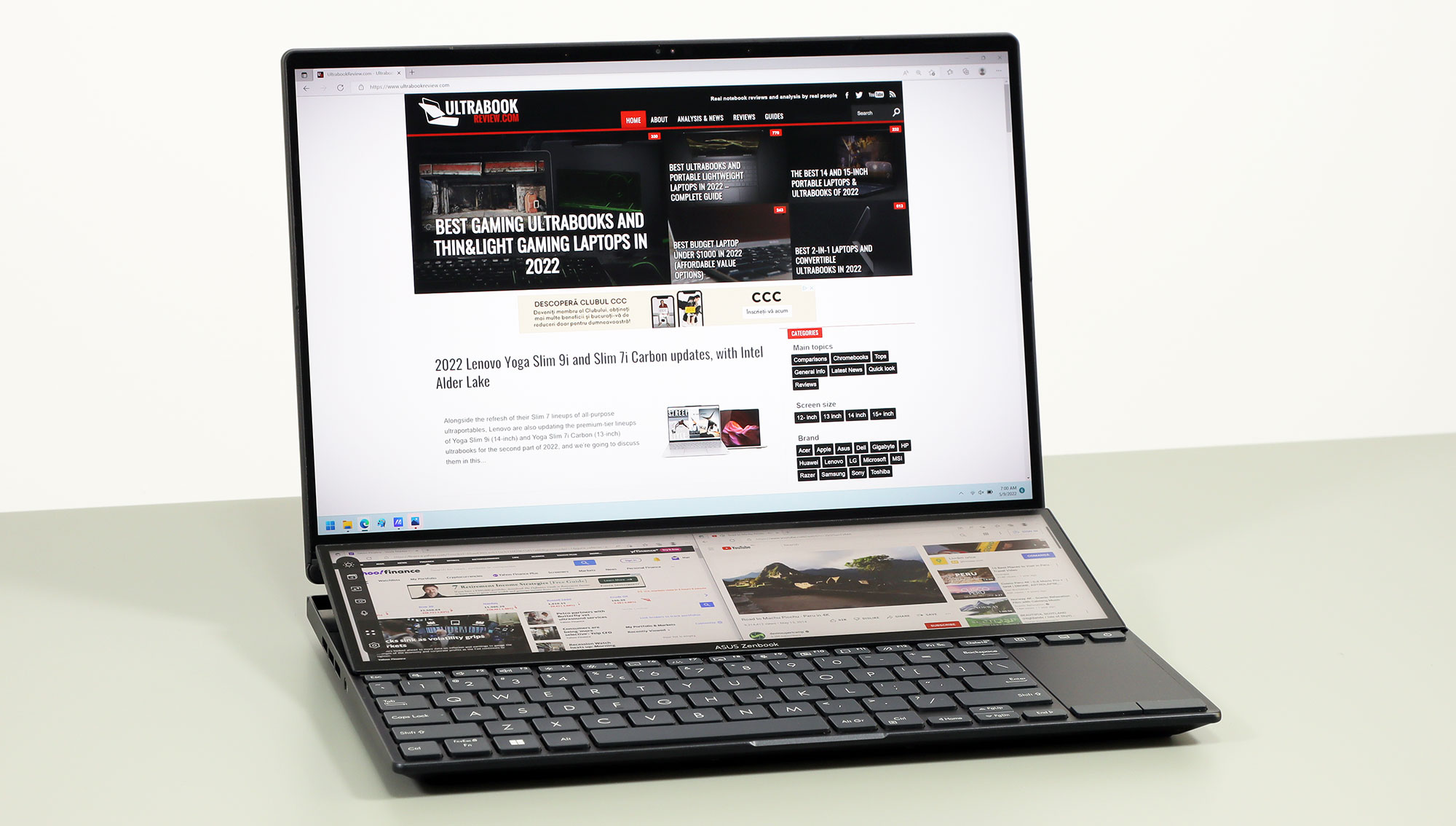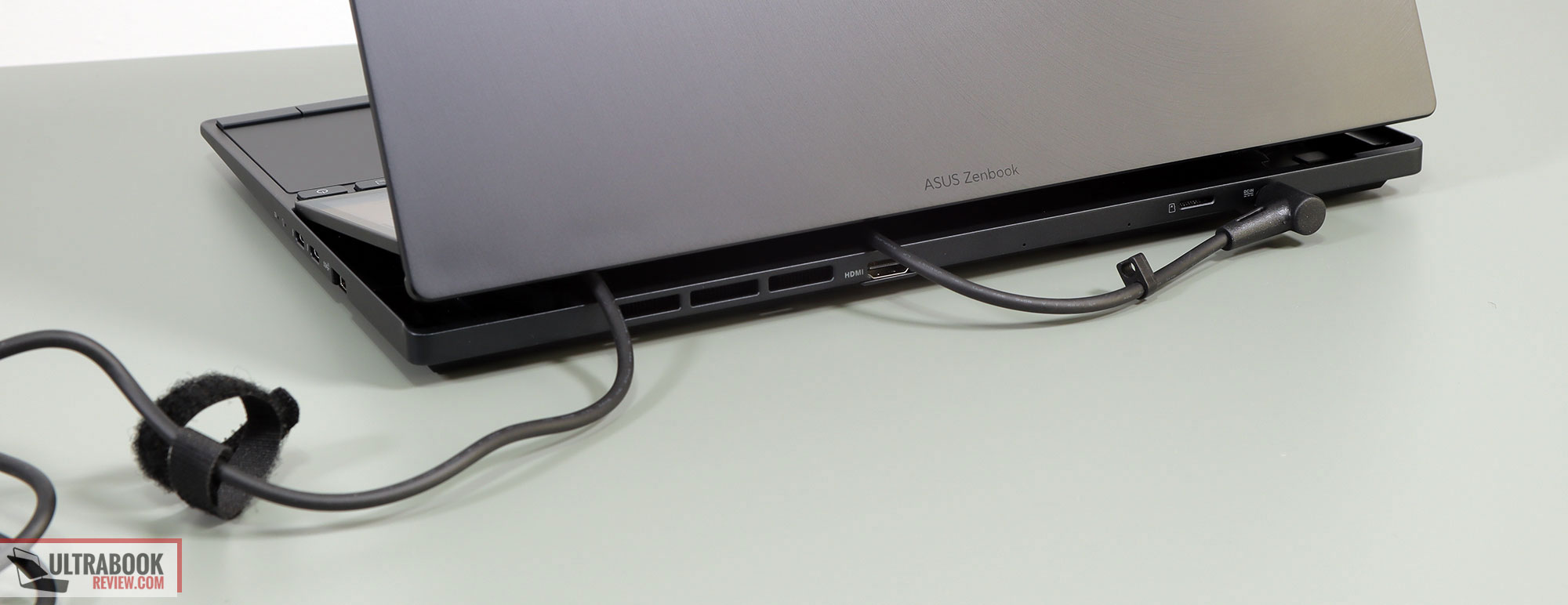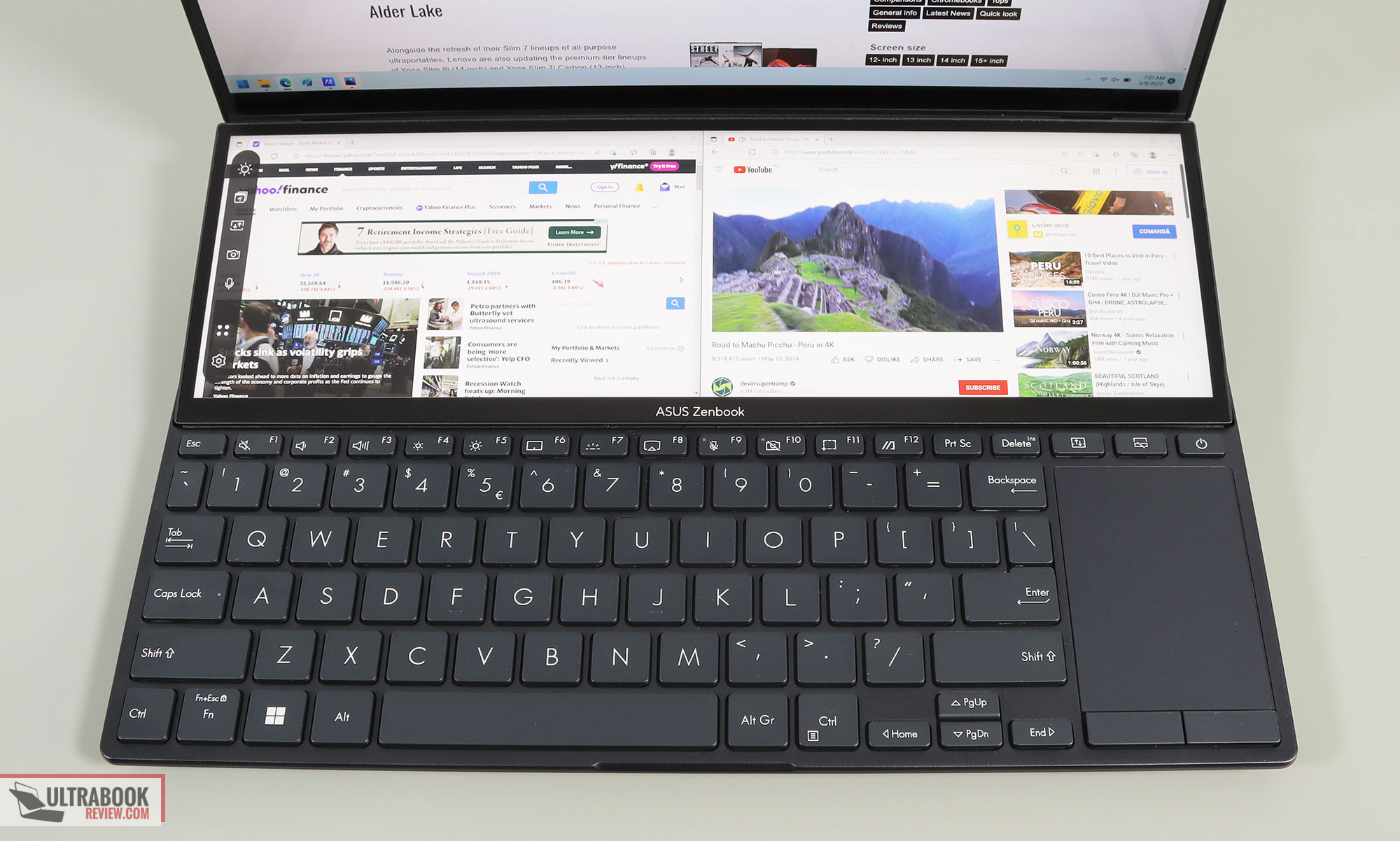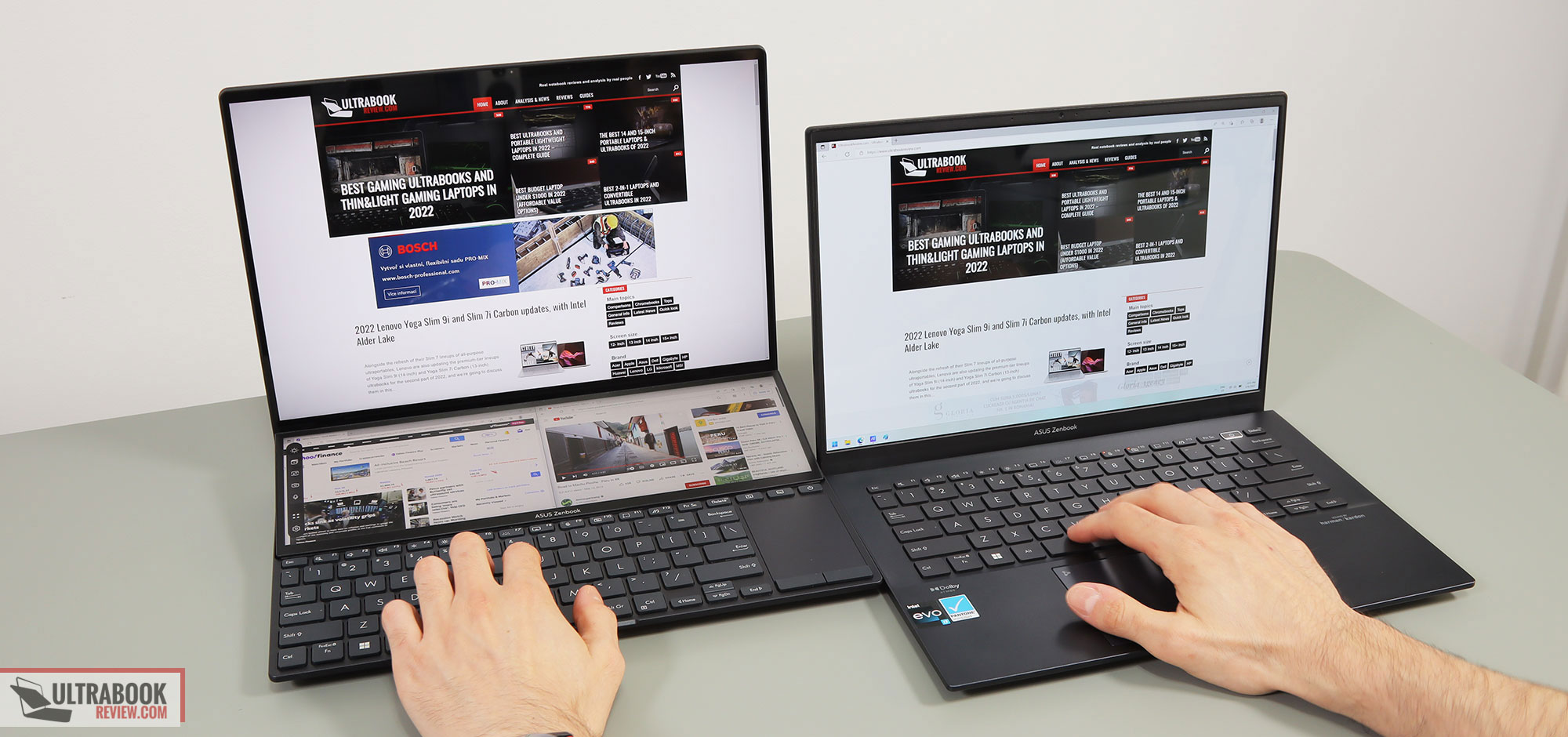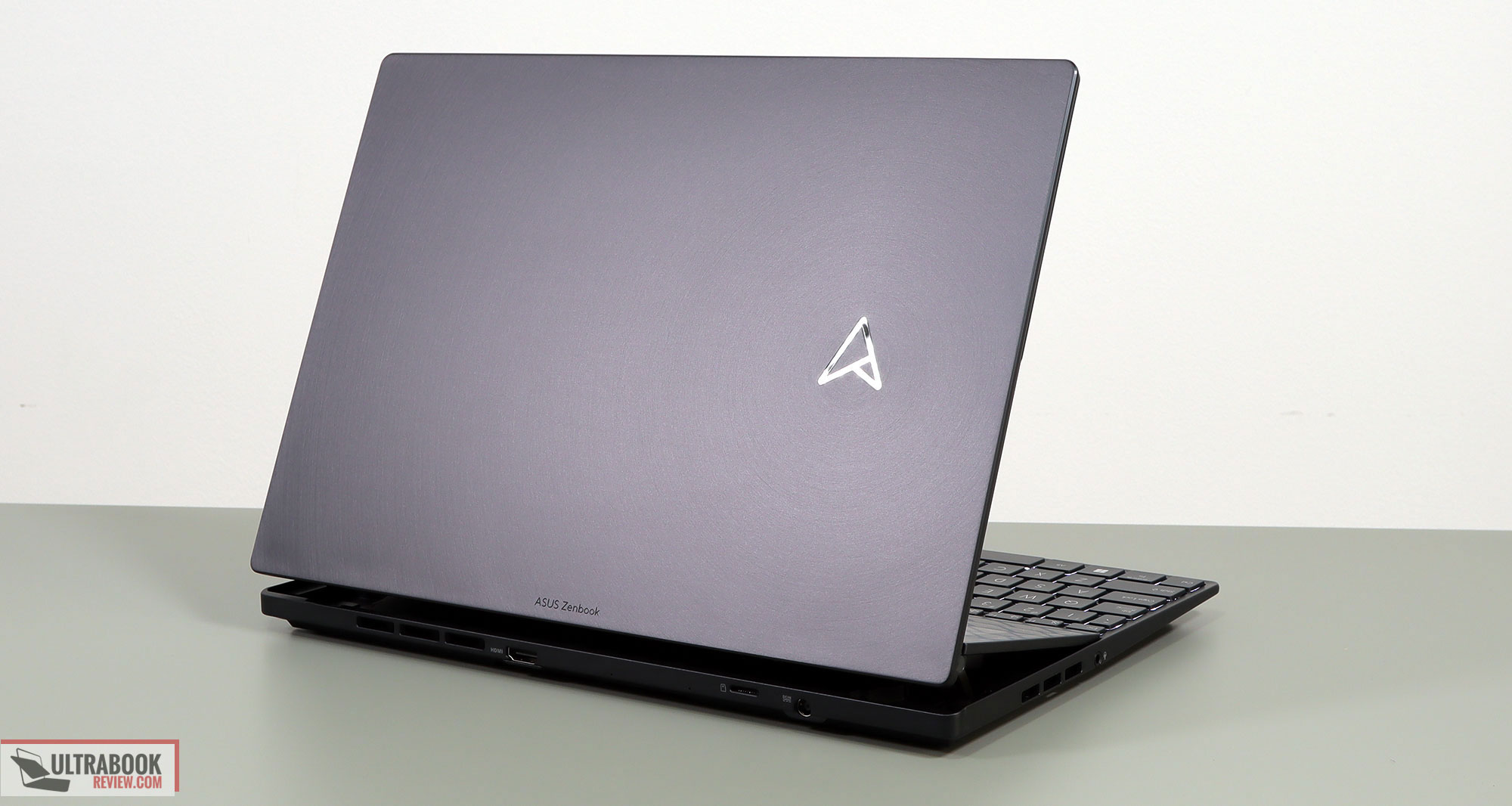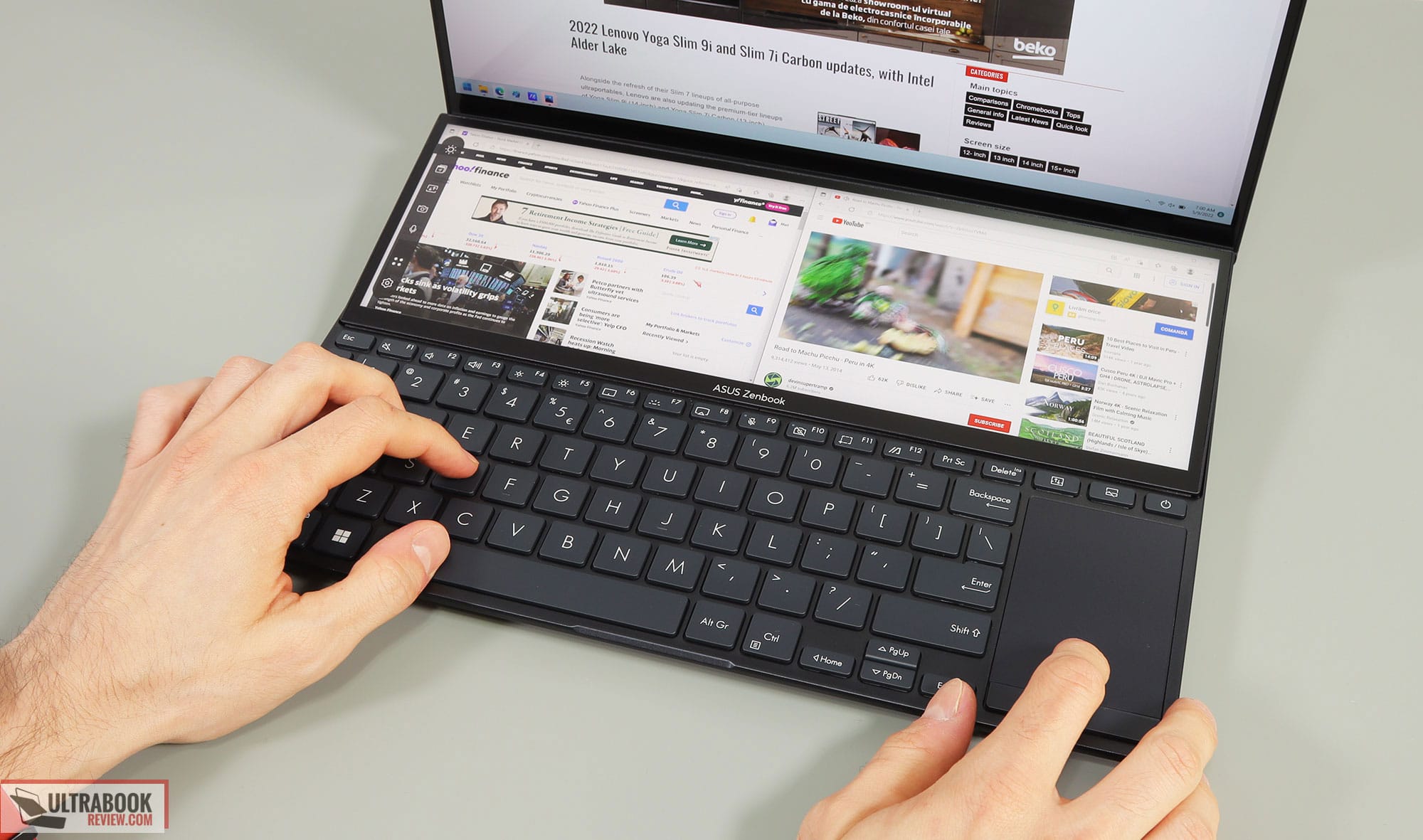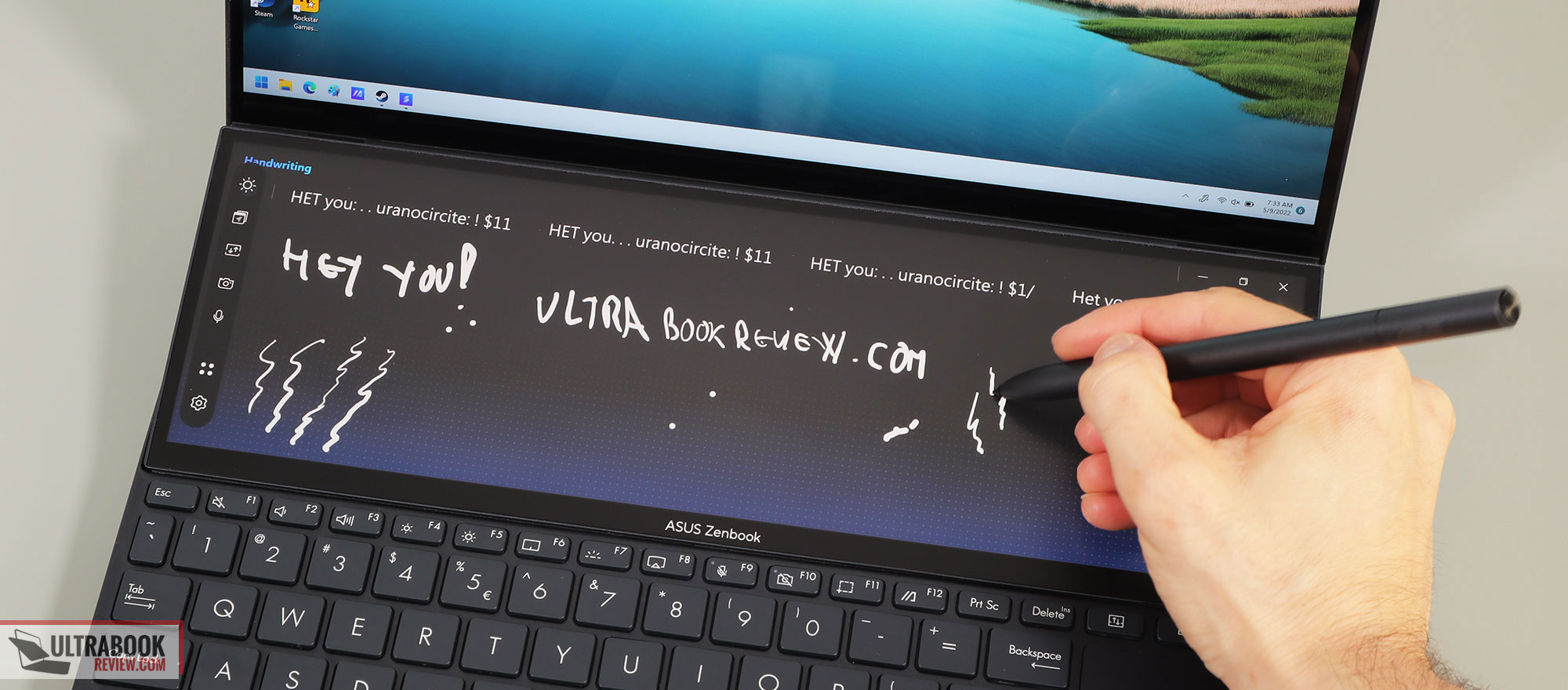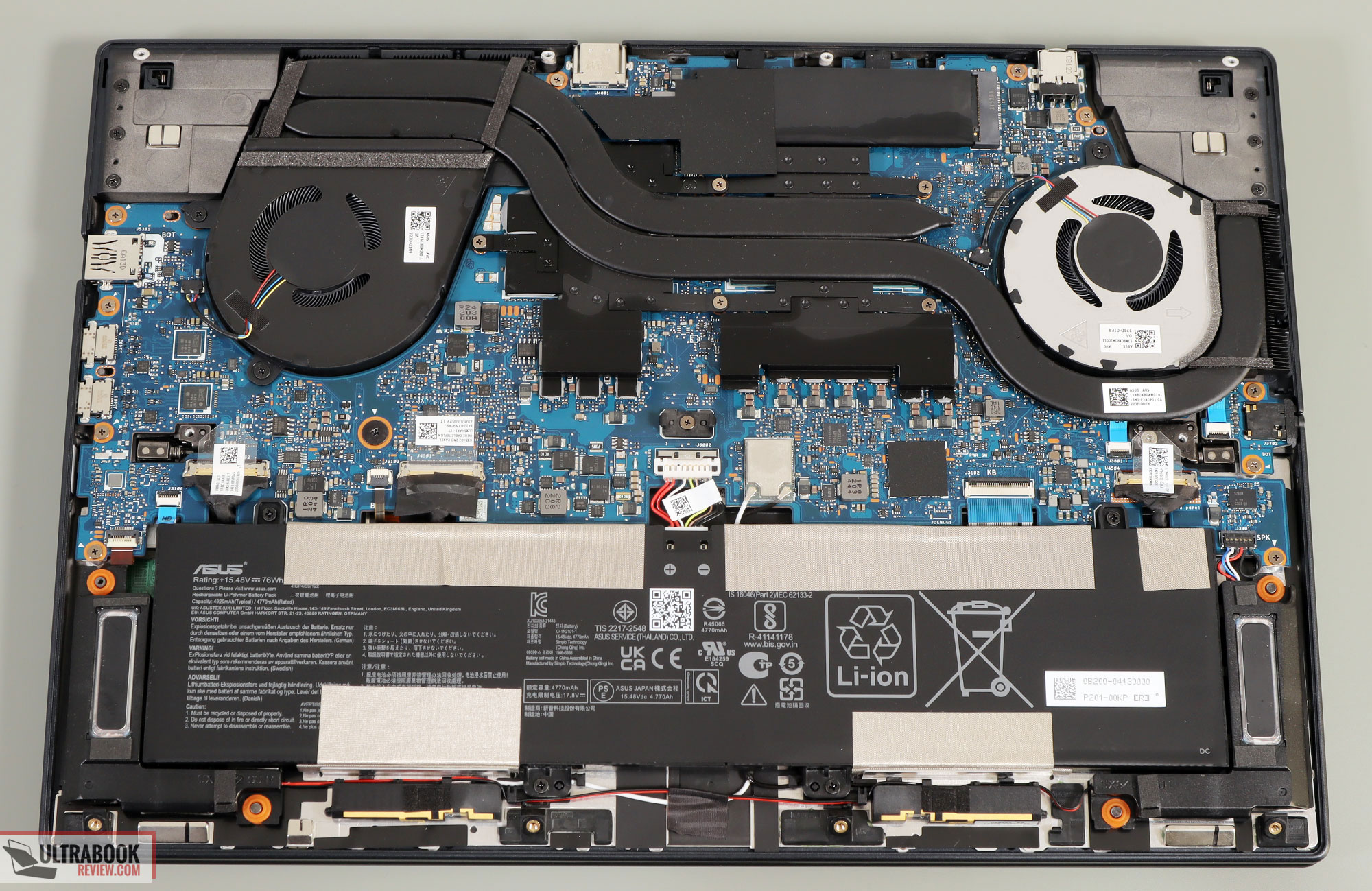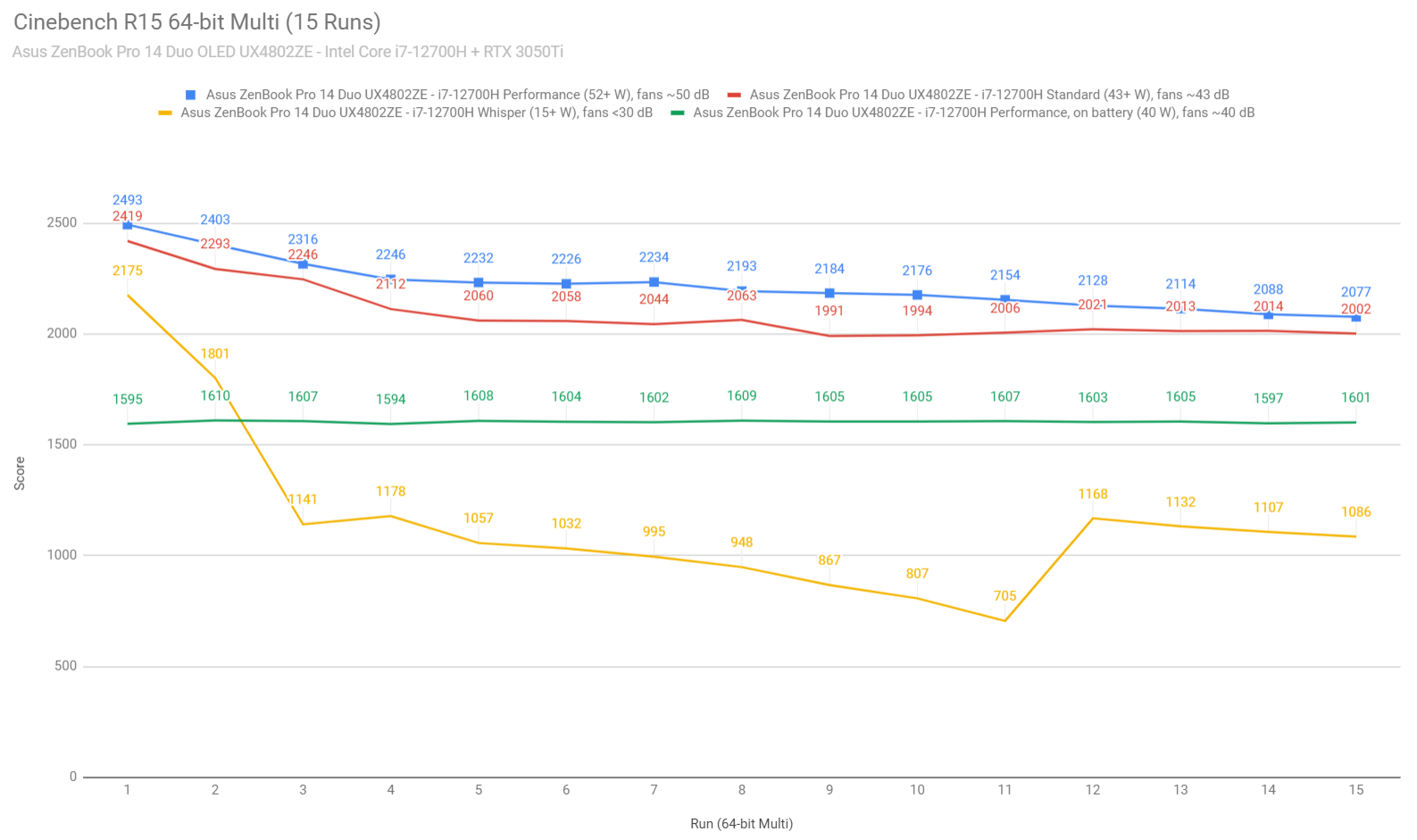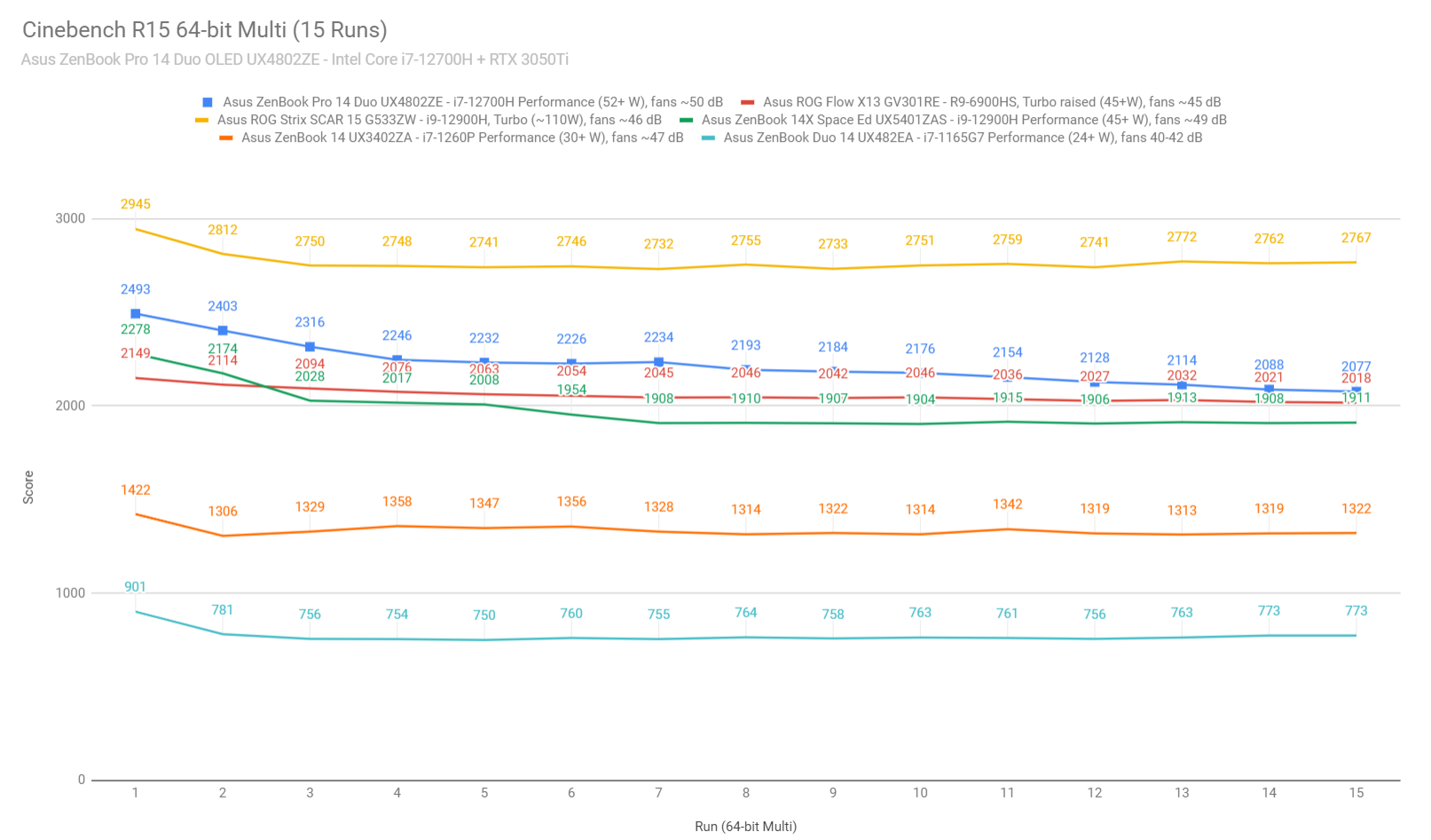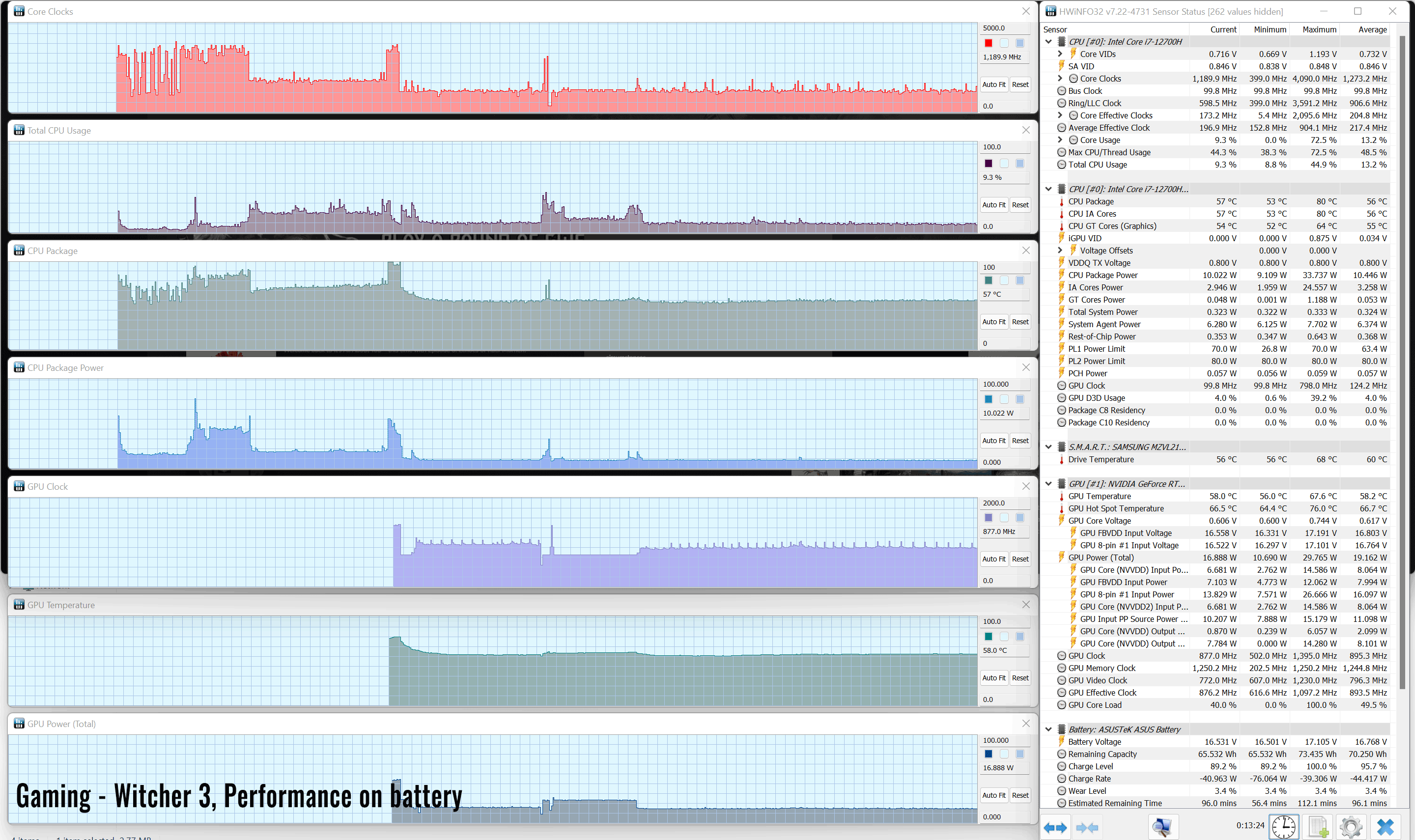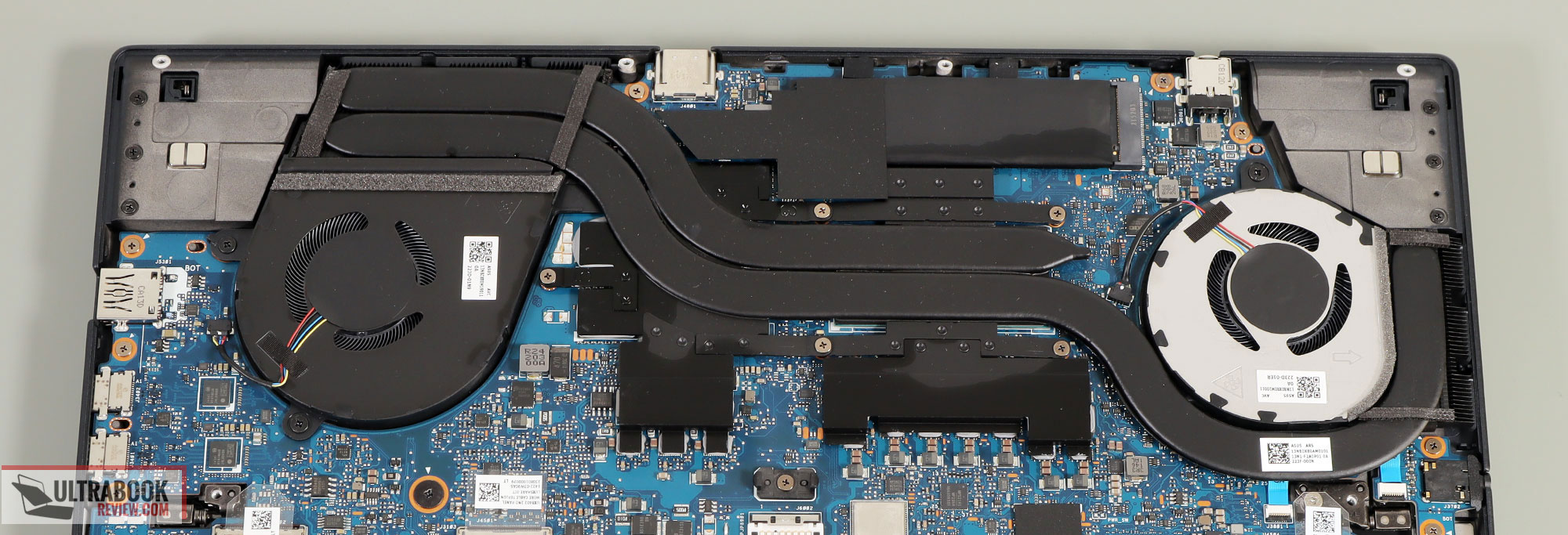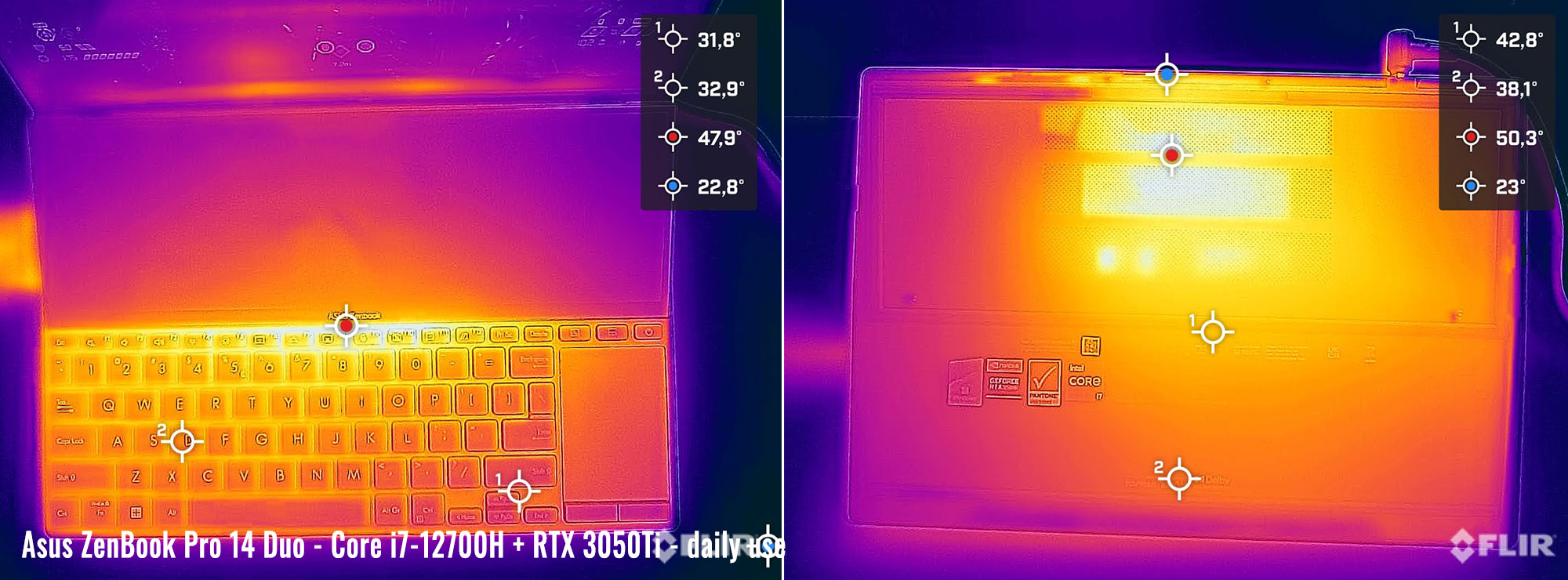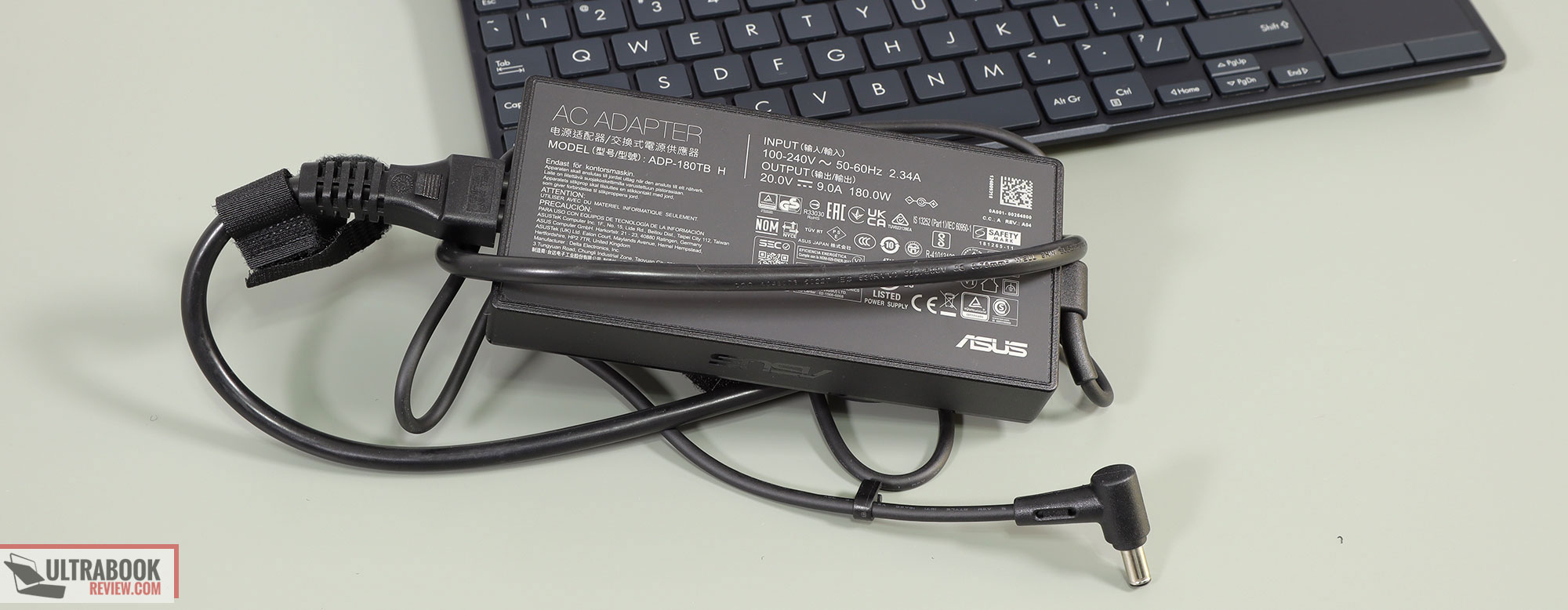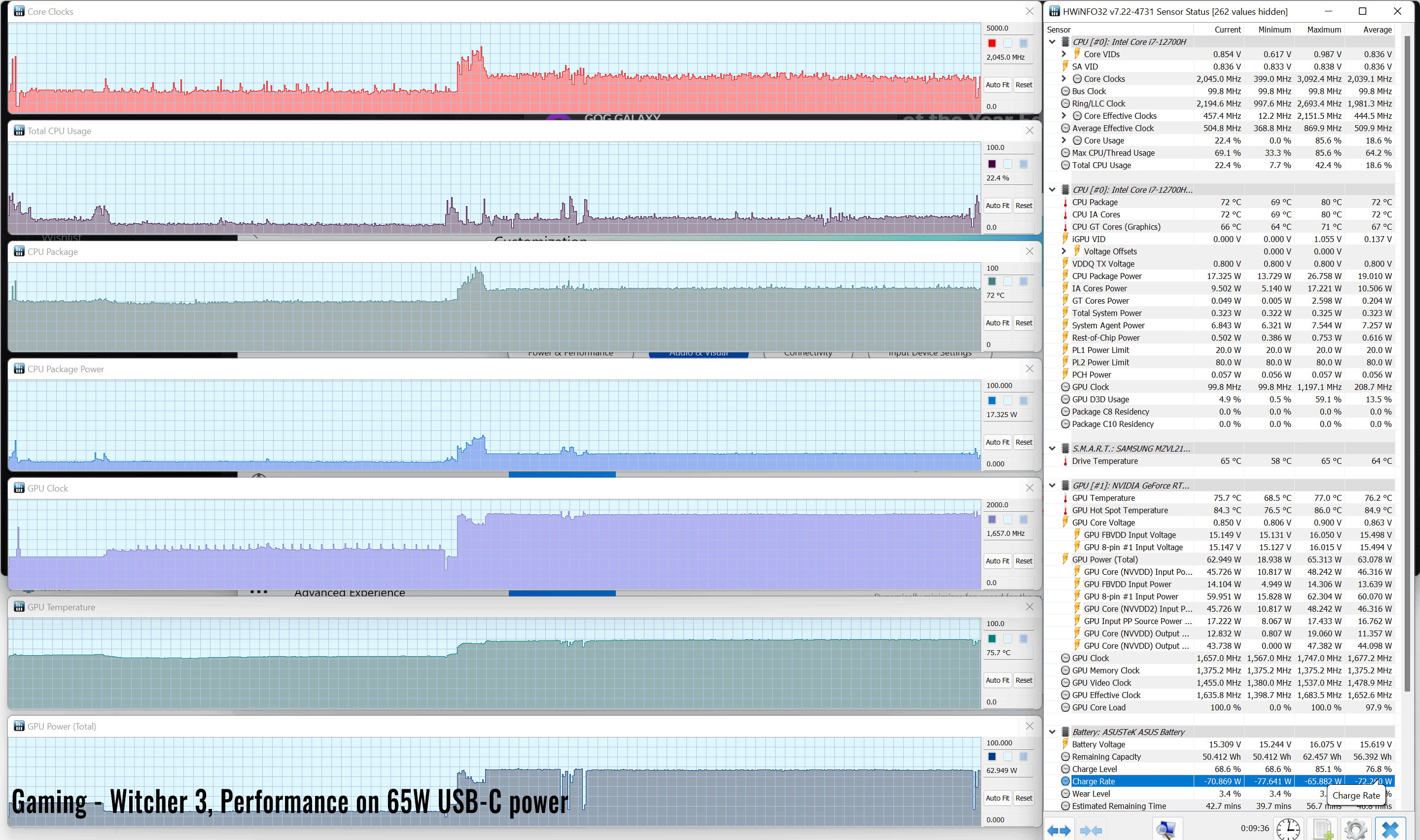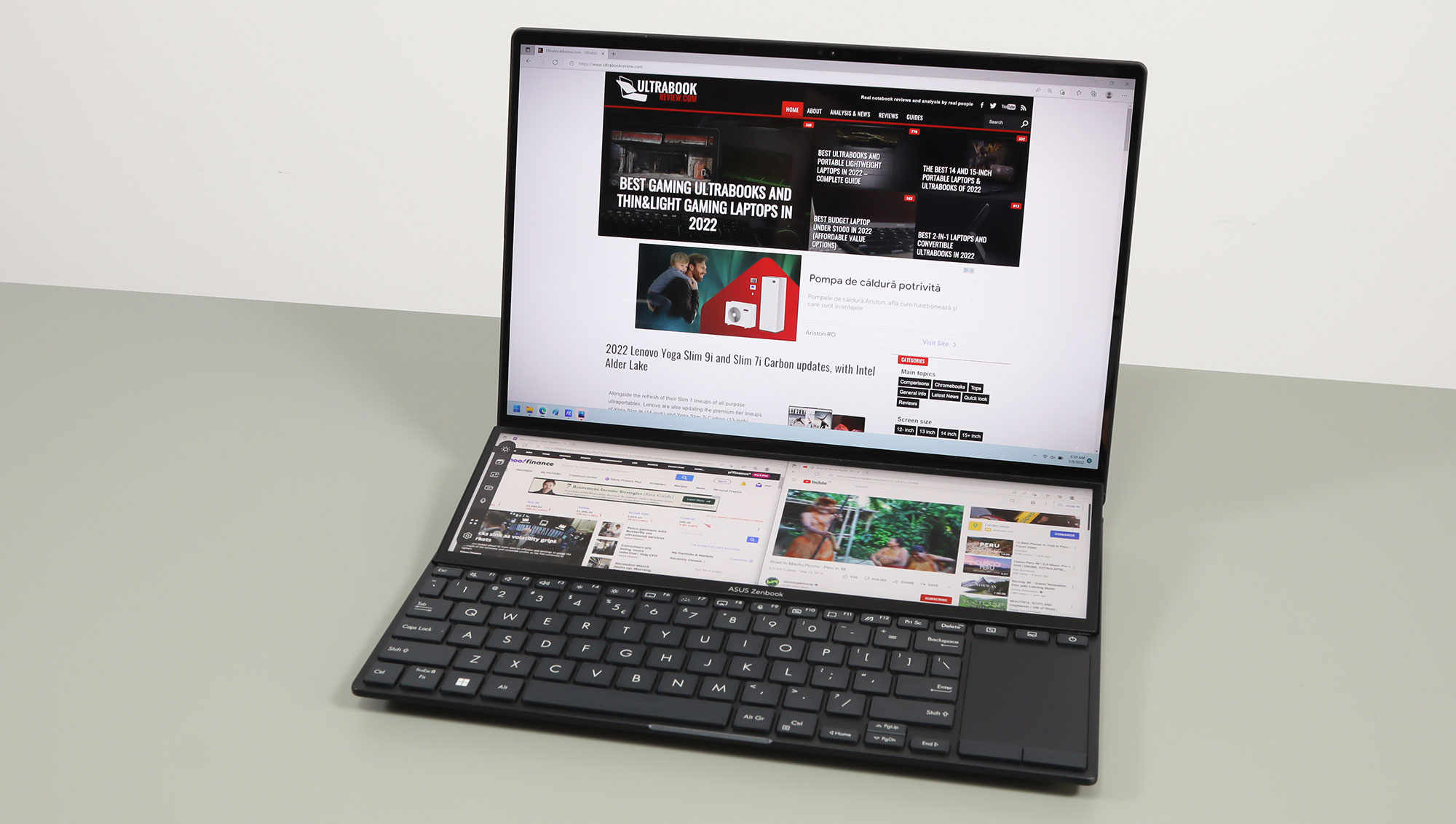
Asus ZenBook Pro 14 Duo OLED UX8402 review (2022 UX8402ZE
[ad_1]
Asus have been offering the ZenBook Duo 14 lineup for a few years now, dual-screen laptops with mid-level performance capabilities and a portable form factor.
This article is all about the latest iteration in the series, the 2022 Asus ZenBook Pro 14 Duo, in the top-tier UX8402ZE configuration. I’ve spent the last week with a unit identical to the ones you’ll be able to find in stores and gathered my thoughts and impressions below.
Compared to the previous Duo models, this now rebranded Pro 14 Duo is significantly more powerful, a little heavier, and ergonomically improved in many ways. Among those, it offers larger displays with higher-quality panels and better viewing angles, a superior IO layout, a larger battery, and an improved thermal module required to cope with the bump in hardware specs.
At the end of the day, though, this series is still all about your need for a dual-display computer. If that’s a must, this Pro 14 Duo is a must-have on your list as well, but you’ll have to accept a few compromises compared to regular single-screen designs with similar capabilities.
So if you have decided that a dual-screen ultrabook is what you want, down below we’ll get in-depth on all the bits and details you should be aware of before going with this 2022 ZenBook Pro 14 Duo.
Specs – Asus ZenBook Pro 14 Duo OLED UX8402ZE
| Asus ZenBook Pro 14 Duo OLED UX8402ZE | |
| Screen | 14.5 inch main display, 16:10 format, glossy, touch, 2.8K 2880 x 1800 px, 120 Hz, OLED, Samsung SDC416D panel 12.7-inch secondary ScreenPad, 32:10 format, matte, touch 2880 x 864 px, 120 Hz, IPS, BOE BOEA8D panel |
| Processor | Intel Alder Lake 12th-gen, Core i7-12700H, 6P+8E/20T Core i5-12500H and i9-12900H variants available |
| Video | Intel Iris Xe + Nvidia RTX 3050Ti 4GB (35-65W) |
| Memory | 16 GB LPDDR5-4800 (soldered) up to 32 GB variants available |
| Storage | 1x M.2 PCIe 4.0 x4 SSD (Samsung PM9A1), single M.2 2280 slot |
| Connectivity | Wireless 6E (Intel AX211), Bluetooth 5.2 |
| Ports | 1x USB-A 3.2 gen2, 2x USB-C 3.2 with Thunderbolt 4, HDMI 2.1, microSD card reader, audio jack |
| Battery | 76 Wh, 180W barrel-plug charger with quick-charging, USB-C charging support up to 100W |
| Size | 311 mm or 12.24” (w) x 221 mm or 8.7” (d) x 16.9 mm or 0.67” (h) |
| Weight | 3.85 lbs (1.75 kg)+ 1.19 lbs (.54 kg) charger + cables, EU version |
| Extras | white backlit keyboard, HD webcam with Hello and RGB sensor, stereo bottom speakers |
Design and construction
Functionally, the ZenBook Pro 14 DUO builds on the design principles of the previous generations, offering a main display in the same place you’re getting the display on regular laptops, but also a secondary half-size screen on the top part of the chassis, which results in the keyboard and the clickpad being pushed down to the front.
What has changed is the entire mechanism that pushes the secondary screen up as you unfold this laptop, allowing for an inclined viewing angle. Paired with a brighter panel and an updated anti-glare finishing, there’s now a lot less content/color shifting, even if you still look at this ScreenPad from a sharp angle. I was a bit skeptical about it when this was mentioned in the presentation, but having spent time with the laptop, I can vouch that I no longer had to pull myself over this ScreenPad to figure out the content on it, and that this implementation is far more usable than before.
Another novelty is the fact that the laptop no longer uses an Ergolift hinge, as in the past. Instead, the main display is attached to the updated ScreenPad mechanism, allowing for narrower bezels, especially at the bottom, between the main display and the ScreenPad. This is also made possible by implementing taller 16:10 format panels on this 2022 model, as opposed to the 16:9 screens available before.
Giving up on the Ergolift hinge allowed Asus to utilize the back-side of this laptop for ports and cooling, as the power plug, card-reader, and HDMI connectors are now placed back there, out of the way. There are also USB-A and USB-C slots with Thunderbolt 4 support on the right edge and an audio jack on the left. The HDMI port hooks into the dGPU, while the two USB-C ports hook into the iGPU. There’s little to complain about the IO selection and layout here, but I would have appreciated a full-size SD card reader instead of the microSD format on this sort of creator-focused product.
At the same time, without the Ergolift hinge, the laptop no longer lifts-up on the back feet in order to improve the airflow into the fans. However, the intakes aren’t choked with this design even with the laptop sitting on the desk, as you’ll see further down in the performance section. Plus, the entire cooling has been redesigned from the previous generation to cope with the more powerful hardware, and hot air no longer blows into the screen, but to the back and the left side, out of the way.
On top of that, Asus includes here an updated version of their Ergolift Stand, two adhesive stands that you can attach on the back of the laptop in order to push it upwards when needed, as shown in the pictures below.
This two-piece stand design is superior to what was offered before and more practical than I expected. They don’t seem to peel off easily, as in the past iterations, and they provide excellent grip and stability on the desk, while improving cooling and the viewing angle on the ScreenPad. Plus, they can be easily folded down closed if you don’t want to use them.
As far as practicality goes, the laptop is sturdily made and easy to operate. With the redesigned hinges, the display goes back to about 160 degrees now, making it more practical to use on the lap. I also appreciate how the status LEDs are tucked away on the right edge, out of sight.
At the same time, with the new hinge mechanism, there’s now a gap at the back between the chassis and the display, where the power cable can easily tangle up. That means you’ll have to be extra careful when closing and opening up this notebook, and try not to force anything, just in case something ends up stuck underneath that moving ScreenPad.
And then there’s the elephant in the room, the position of the inputs at the front of the main chassis.
This laptop is alright as long as it’s kept on a spacious desk, with enough support for your arms, since there’s no arm-rest or wrist-pad.
However, as a result of this front-shifted keyboard you pretty much have to push the laptop 10-15 cm further away from you to place your hands in the regular typing position over the keys. That means the screen ends up further away from your eyes, and that’s why this ZenBook Duo doesn’t feel like a regular 14-inch computer, but more like something with a sub-13-inch display. I had to scale up the Windows interface more than on a regular 14-inch notebook to limit squinting at the content.
This is better illustrated by the images down below, where you can see the ZenBook Pro 14 Duo next to the regular 2022 ZenBook 14 ultrabook.
Furthermore, the front keyboard makes the ZenBook DUO rather impractical in tight spaces or on the lap or tighs, where the lack of any sort of arm support becomes more obvious. In these situations, you’ll pretty much have to T-rex your hands to be able to type on this thing.
Now, your impressions might differ from mine, but I think it is very important to be aware of these design/ergonomic particularities that you’ll have to accept when looking at this kind of computer. For me, this only makes sense on a desk.
One final aspect I will touch on here is the slight aesthetic redesign of this ZenBook Pro Duo series, with the cleaner lid design and a more muted pattern of concentric circles. Asus are implementing these new design lines on the entire 2022 ZenBook lineups, and I’m glad to see them steering towards a more modern approach. The dark-gray lid still shows some smudges, but less so than the shinier finishing used before. And it just looks way better!
Keyboard and trackpad
I wasn’t a fan of the previous keyboards implemented on the 14-inch ZenBook Duos because of their cramped layout with 13 x 14 mm keys.
With this generation, though, Asus were able to put a more standard keyboard on this chassis, with 15 x 15 mm main keys. The layout is still more cramped than what you’ll get in a regular ZenBook 14, with the smaller side (Caps Lock, Shift, Enter) keys, but it is usable.
A layout particularity for this series are the extra keys at the top of the clickpad, meant for ScreenPad control. One activates/deactivates the ScreenPad, and the other allows to move applications between the two displays easily.
The dark-gray finishing of the keycaps doesn’t seem to smudge easily and feels nice to the touch, with the slight dash in each key. In fact, the overall feedback and typing experience are solid here, in-line with the average ultraportable experience out there. I would expect those of you with large hands to somewhat struggle with the layout, though.
The backlighting system is fine as well, with white LEDs and 3 brightness levels to choose from. The layout includes indicators for Caps-Lock and for the camera/mic on the F9/F10 keys, and the light reactivates with a swipe over the clickpad/keys when it times out. Asus also implemented a light-sensor that allows to only activate the backlighting in dimmer environments.
The clickpad is still a narrow glass surface on the keyboard’s right side. Asus have updated the matte finishing and slightly indented it from the chassis so you can easily tell where the surface ends. It handles taps and swipes fine, and all the standard gestures, but there’s only so much you can do before feeling you’re out of space with this sort of ultra-narrow design.
I do like the physical click buttons, though; they’re very tactile, smooth, and quiet.
As far as the IO goes, there’s no finger sensor with this design, but you do get IR Hello support included with the camera.
Screen
You’re getting two screens on the ZenBook Pro 14 DUO, and both panels have been updated from the previous generations.
The main display is now a 14.5-inch 16:10 2.8K OLED panel, with 550 nits of advertised brightness and 100% DCI-P3 color coverage, as well as the perfect blacks and the fast response times characteristic to OLEDs, plus 120 Hz refresh rate in this implementation.
The 550-nits of peak brightness part is somewhat misleading for these OLED panels. In our tests, I measured sub-400-nits of sustained brightness in a 16% white window (with the rest of the screen being black) with the display set on SDR mode, and around 400-nits on HDR mode. The 550-nits is probably recorded in a much smaller window, so don’t expect this screen to feel like a 500+ nits IPS when used in bright light environments, especially where the glare provided by the touch glass layer adds into the mix.
Here’s what we got in our tests, with an X-Rite i1 Display Pro sensor (with HDR mode disabled):
- Panel HardwareID: Samsung SDC416D (ATNA45AF01-0);
- Coverage: 100% sRGB, 97.5% Adobe RGB, 99.6% DCI-P3;
- Type: 10-bit with HDR500;
- Measured gamma: 2.23;
- Max brightness in the middle of the screen: 350.84 cd/m2 on power;
- Min brightness in the middle of the screen: 1.43 cd/m2 on power;
- Contrast at max brightness: 1:1;
- White point: 6500 K;
- Black on max brightness: 0 cd/m2;
- PWM: No.
This panel came very well calibrated out of the box and turned out to be uniform in luminosity and color. Plus, since this is OLED, you don’t have to worry about any light bleeding on black backgrounds.
At the same time, you should also consider the other advantages of OLED panels, such as the lower blue-light emission and the way colors are perceived more vividly at medium brightness levels, but also the potential downsides of OLED panels on a laptop, such as black-crush, gray-bending, flickering, and even burn-in to some extent. I wouldn’t worry about burn-in as much as with past OLED generations, as both Asus and Samsung implement technologies meant to prevent any long-term damage, as explained in our ZenBook 14X Space Edition review.
As for the ScreenPad display, that’s a 32:10 12.7-inch IPS touch panel in a matte anti-glare implementation. This is much brighter and richer than the panel used on past ZenBook DUO models, and makes for a much-improved viewing experience on this secondary display.
Here’s what we got in our tests, with an X-Rite i1 Display Pro sensor:
- Panel HardwareID: BOE BOE0A8D (NV127H4M-NX1);
- Coverage: 99.9% sRGB, 90.0% Adobe RGB, 97.0% DCI-P3;
- Type: 8-bit;
- Measured gamma: 2.23;
- Max brightness in the middle of the screen: 657.794 cd/m2 on power;
- Contrast at max brightness: 1034:1;
- White point: 6900 K;
- Black on max brightness: 0.63 cd/m2;
- PWM: No.
This can be somewhat further calibrated to address the skewed Gamma and White point, and ends up uniform once calibrated.
Both screens support finger-touch and work with the included pen. This is a new design with a built-in battery that charges via USB-C, and a few different pen heads included in the box. You can use it for sketches, drawings, or handwriting. The experience seems improved from the previous generation, but I still feel that hand rejection on the ScreenPad needs more work. I don’t have much experience with pens, though, so take my impressions with a lump of salt.
Furthermore, Asus keep working on their ScreenPad software to add extra functionality that people would use on this dual-display format.
The available software allows to create preset batches of apps on the two displays, and there’s also support for customizable toolbars for third-party applications such as Photoshop, After Effects, or Premiere (and hopefully others in the future). The video below showcases the previous ScreenXpert 2 version of the Screenpad software, and I’ll update with the current ScreenXpert 3 generation when I can find a similar clip.
Hardware and performance
Our test model is a top-specced configuration of the Asus ZenBook Pro 14 DUO in the UX8402ZE configuration, with an Intel Core i7-12700H processor, Intel Iris Xe iGPU and an Nvidia RTX 3050Ti dedicated graphics chip, 16 GB of LPDDR5-4800 memory, and a very fast 1 TB gen4 SSD.
Disclaimer: This review unit was provided by Asus for this article. We tested it with the early software available as of early-May 2022 (BIOS 206, MyAsus 3.1.3 app, ProArt Center 1.2.20.0), thus some aspects might change with future software updates.
Spec-wise, this is based on the 2022 Intel 12th-gen Alder Lake hardware platform. Our configuration is the mainstream Core i7-12700H processor, the hybrid design with 6 Performance and 8 Efficiency Cores, and 20 combined threads. This portable implementation supplies the CPU with 50+W of power in sustained loads, so don’t expect it to match the higher-power implementations in full-size computers.
Graphics are handled by a GeForce RTX 3050Ti dGPU on this model, with 4 GB of vRAM and running at up to 65W of power with Dynamic Boost. This is more powerful than other compact 3050Ti laptops such as the ROG Flow units or the VivoBook Pro 14X.
You’ll also find iGPU-only configurations of this laptop, with the integrated Iris Xe chip with 96 EUs and frequencies of up to 1.45 GHz.
Our configuration also comes with 16 GB of LPDDR5-4800 memory, in dual-channel. 8, 16, and 32 GB configurations are available for the series, and the memory is onboard and non-upgradeable.
For storage, Asus opted for a fast PCIe gen4 Samsung PM9A1 drive here, which performed admirably in our tests.
The SSD is the only upgradeable component here. To get inside, you need to remove the back panel that is held in place by a couple of Torx screws, all visible around the sides.
As far as the software goes, this ZenBook gets the standard MyAsus app which allows control over the power profiles, battery and screen settings, updates, etc, but also the ProArt Creator Hub control center that’s usually available with the ProArt series of creator computers.
There are three performance/thermal profiles to choose from:
- Performance – allows the hardware to run at full power, with fans ramping up to 50 dB;
- Standard – limits the CPU/GPU power to some extent, with fans ramping up to 43 dB;
- Whisper – limits the performance to favor lower fan noise of sub 30 dB.
Whisper mode is perfectly suited for daily use, and Standard is what I’d mostly recommend for demanding combined loads, because of the much noisier fans on the Performance mode.
We’ll get to that in a bit, but first, here’s what to expect in terms of speeds and temperatures with daily use. This runs mostly silent with basic use on the Standard profile, but the fans kick on with multitasking and are audible in a quiet room. If you don’t want that, you’ll have to switch to Whisper mode.
Performance and benchmarks
On to more demanding loads, we start by testing the CPU’s performance by running the Cinebench R15 test for 15+ times in a loop, with a 1-2 seconds delay between each run.
On the Performance mode, the Core i7-12700H processor peaks at the 80W PL2 setting for a little while and then gradually drops and stabilizes around the 54W PL1 power limit, with temperatures of 82-85 degrees Celsius, and fan-noise levels of ~50 dB. These result in sustained Cinebench scores of around 2100 points.
On Standard, the system limits the fans to around 43 dB. The CPU ends up stabilizing at ~43W, with temperatures in the high-70s. The performance only takes a minor 5% hit compared to the Performance mode, with the scores stabilizing around 2000 points.
You can also opt for the Whisper mode, with limits the CPU to 25-15W with now barely audible fans and temperatures in the mid-60s. The laptop only performs at 40-50% of its abilities on this profile.
Finally, our sample ran at 40W sustained on the Performance mode on battery, which translated into solid performance and scores, with fan noise levels around 40 dB.
To put these in perspective, here’s how this i7-12700H implementation fares against other i7/i9 chips, in either portable or full-size formats. I’ve also included the Ryzen 9 variants of the 2022 Flow X13 ultraportable designs in here, as well as the previous i7-1165G7 implementation in the 2021 ZenBook 14 DUO.
We then went ahead and further verified our findings with the more taxing Cinebench R23 loop test and in Blender, confirming our above findings.
We then ran the 3DMark CPU profile test.
Finally, we ran our combined CPU+GPU stress tests on this notebook, on the Turbo profile. 3DMark stress runs the same test for 20 times in a loop and looks for performance variation and degradation over time, and this unit passed it just fine, which means there’s no combined performance throttling with longer-duration sustained loads.
Next, we ran the entire suite of tests and benchmarks, on the Performance profile in ProArt Hub, at FHD 1920 x 1080 px resolution for consistency with our other tests, and with the laptop sitting on the desk.
- 3DMark 13 – Fire Strike: 12413 (Graphics – 13530, Physics – 26519, Combined – 5137);
- 3DMark 13 – Port Royal: 565;
- 3DMark 13 – Time Spy: 5835 (Graphics – 5345, CPU – 12150);
- Uniengine Superposition – 1080p Extreme: 3079;
- Uniengine Superposition – 1080p Medium: 9844;
- Handbrake 1.3.3 (4K to 1080p encode): 58.68 average fps;
- PassMark 10: Rating: 6737 (CPU: 30281, 3D Graphics: 11805, Memory: 2875, Disk: 39986);
- PCMark 10: 6749 (Essentials – 10271, Productivity – 8857, Digital Content Creation – 9173);
- GeekBench 5.4.3 64-bit: –Single-Core: 1513, Multi-core: 8521;
- CineBench R15 (best run): CPU 2493 cb, CPU Single Core 257 cb;
- CineBench R20 (best run): CPU 6022 cb, CPU Single Core 682 cb;
- CineBench R23: CPU 15618 cb (best run), CPU 13870 (10 min loop test), CPU Single Core 1772 CB (best run);
- x265 HD Benchmark 64-bit: 26.38 s.
And here are some workstation benchmarks, on the same Turbo profile:
- Blender 3.01 – BMW Car scene- CPU Compute: 2m 43s ;
- Blender 3.01 – BMW Car scene- GPU Compute: 44s (CUDA), 23s (Optix);
- Blender 3.01 – Classroom scene – CPU Compute: 6m 38s;
- Blender 3.01 – Classroom scene – GPU Compute: 1m 32s (CUDA), 51s (Optix);
- PugetBench – DaVinci Resolve: 923 points;
- PugetBench – Adobe After Effects: crashed;
- PugetBench – Adobe Photoshop: 820;
- PugetBench – Adobe Premiere: 782;
- SPECviewperf 2020 – 3DSMax: 58.25;
- SPECviewperf 2020 – Catia: 33.79;
- SPECviewperf 2020 – Creo: 71.22;
- SPECviewperf 2020 – Energy: 11.09;
- SPECviewperf 2020 – Maya: 211.02;
- SPECviewperf 2020 – Medical: 17.95;
- SPECviewperf 2020 – SNX: 12.23;
- SPECviewperf 2020 – SW: 124.75.
- V-Ray Benchmark: CPU – 8293 vsamples, GPU CUDA – 206 vpaths;
These are solid results for a 14-inch computer. It’s not a match for similarly sized single-screen devices like an Asus ROG Zephyrus G14 or Razer Blade 14, but it is faster than most other sub-14-inch options with similar specs, as a result of running the hardware and fairly high power settings.
On the CPU side, the i7-12700H in this unit scores very well in short-duration tests, and competitively in longer loads, once the allocated CPU power settles around 50-55 W on the Performance mode.
On the GPU side, the 3050Ti can run at up to 65W in this design, and that allows it to outscore the 3050Ti variants of the ROG Flow Z13/X13 or the VivoBook Pro 14X, which only go up to 40-50W. In fact, this Pro 14 DUO even outscores the Dell XPS 15, a popular option in the creator space.
As for the comparison with the previous-gen 2021 ZenBook 14 DUO, the 2022 model in this i7+3050Ti configuration ends up 2x faster in CPU multi-threaded and GPU loads.
All these are possible while ramping up the fans to loud levels of 48-50 dB, which might not be acceptable for some of you. If that’s the case, you could opt for the Standard power profile instead, which limits the fans at up to 43 dB.
Here are some comparing benchmarks scores on this Standard mode.
- 3DMark 13 – Fire Strike: 11044 (Graphics – 12117, Physics – 26112, Combined – 4366);
- 3DMark 13 – Time Spy: 5135 (Graphics – 4669, CPU – 11850);
- Uniengine Superposition – 1080p Medium: 8766;
- CineBench R20 (best run): CPU 5630 cb, CPU Single Core 596 cb;
- x265 HD Benchmark 64-bit: 29.84 s.
The CPU takes a ~10% performance hit in multi-threaded loads, and doesn’t run any warmer. The single-core scores drop by 20%, though, and that can impact certain workloads.
At the same time, the GPU only runs at up to 45W of power in this mode, resulting in a 15-20% decrease in processing capabilities. Up to you if these are worth it for the quieter fan experience, but as far as I’m concerned, this Standard mid-level profile is a well-balanced setting for this laptop.
Gaming performance
This ZenBook is not primarily made for gaming and even runs on Studio Edition drivers, but considering the hardware and the fast response/refresh of the OLED display, I’d still expect many of you to run games on it time and again.
Hence, we ran a couple of DX11, DX12, and Vulkan titles on the Performance and Standard profiles of this Core i7 + 3050Ti configuration, at FHD+ resolution, with Ultra and Medium graphics settings.
For starters, here’s what we got on Ultra settings.
| Intel Core i7-12700H + RTX 3050Ti Laptop 35-65W |
FHD+ on Performance mode – RTX 3050Ti running at 50-65W |
FHD+ on Standard mode – RTX 3050Ti running at 35-45W |
| Dota 2 (DX 11, Best Looking Preset) |
108 fps (59 fps – 1% low) | 97 fps (51 fps – 1% low) |
| Far Cry 5 (DX 11, Ultra Preset, SMAA) |
74 fps (54 fps – 1% low) | 62 fps (40 fps – 1% low) |
| Far Cry 6 (DX 12, Ultra Preset, TAA) |
60 fps (31 fps – 1% low) | 51 fps (27 fps – 1% low) |
| Red Dead Redemption 2 (DX 12, Ultra Optimized, TAA) |
56 fps (39 fps – 1% low) | 47 fps (33 fps – 1% low) |
| Shadow of Tomb Raider (DX 12, Highest Preset, TAA) |
66 fps (47 fps – 1% low) | 56 fps (42 fps – 1% low) |
| The Witcher 3: Wild Hunt (DX 11, Ultra Preset, Hairworks On 4) |
72 fps (54 fps – 1% low) | 62 fps (37 fps – 1% low) |
- Battlefield V, The Witcher 3 – recorded with Fraps/in-game FPS counter in campaign mode;
- Far Cry 5, Middle Earth, Strange Brigade, Red Dead Redemption 2, Tomb Raider games – recorded with the included Benchmark utilities;
- Red Dead Redemption 2 Optimized profile based on these settings.
Even recent titles are running fine on this configuration at FHD+ resolution.
This outmatches devices such as the VivoBook Pros (AMD or Intel based, and up to 50W 3050Ti), beats the XPS 15 (11th gen Core i7 + 3050Ti 40W) across the board, and is a match for the 2021 Zephyrus G14 running on the 60-75W 3050Ti. Not bad at all!
However, if you’re going to game on this mini-computer, I’d recommend trimming down on the details and keeping with the quieter Standard mode.
Here’s what we got on Medium settings at FHD+ resolution on the Standard profile. I also added a couple of matching platforms, for comparison.
| Medium settings | ZenBook Pro Duo – Core i7 + 3050Ti 35+W FHD+ resolution |
ROG Flow X13 – Ryzen 9 + 3050Ti 35+W FHD+ resolution |
ROG Flow Z13 – Core i9 + 3050Ti 35+W FHD+ resolution |
XPS 15 9510 – Core i7 + 3050 35+W FHD resolution |
VivoBook Pro 16X – Core i7 + 3050 35+W FHD+ resolution |
VivoBook Pro 14X – Ryzen 7 + 3050Ti 35+W FHD+ resolution |
| Doom Eternal (Vulkan, Medium Preset, no DLSS) |
118 fps (79 fps – 1% low) | 107 fps (82 fps – 1% low) | 126 fps (89 fps – 1% low) | – | – | – |
| Far Cry 5 (DX 11, Normal Preset, TAA) |
72 fps (59 fps – 1% low) | 74 fps (57 fps – 1% low) | 72 fps (48 fps – 1% low) | 72 fps (54 fps – 1% low) | 69 fps (57 fps – 1% low) | 76 fps (44 fps – 1% low) |
| Red Dead Redemption 2 (DX 12, Balanced – first option) |
47 fps (35 fps – 1% low) | 48 fps (32 fps – 1% low) | 46 fps (30 fps – 1% low) | 50 fps (34 fps – 1% low) | 47 fps (34 fps – 1% low) | 51 fps (39 fps – 1% low) |
| Shadow of Tomb Raider (DX 12, Medium Preset, TAA) |
68 fps (56 fps – 1% low) | 69 fps (48 fps – 1% low) | 68 fps (45 fps – 1% low) | 52 fps (26 fps – 1% low) | 62 fps (40 fps – 1% low) | 66 fps (52 fps – 1% low) |
| The Witcher 3: Wild Hunt (DX 11, Medium Preset, Hairworks Low) |
105 fps (59 fps – 1% low) | 102 fps (78 fps – 1% low) | 98 fps (59 fps – 1% low) | 92 fps (59 fps – 1% low) | 89 fps (65 fps – 1% low) | 98 fps (73 fps – 1% low) |
Even on the mid-range Standard profile and without implementing a MUX, this ZenBook Pro 14 Duo UX8402 is competitive against all the other options listed above, including the ROG Flow units.
With these out of the way, let’s go through some of the performance logs on each profile.
On the Performance mode, the hardware runs at up to 85W of combined CPU+GPU power. That translates in up to 65W allocated to the GPU in titles that scale well with Dynamic Boost, such as Witcher or Red Dead 2, but only around 50 W in others, such as the Far Cry titles.
As far as the temperatures go, we measured between 70-75 degrees Celsius on both components in most of the tested games. Those are excellent temperatures, especially considering we’re keeping the laptop on the desk for these tests.
Bumping up the back on the foldable kickstands only has a minor impact over the temperatures, dropping by 1-3 degrees on this Performance mode. That’s because the majority of fresh air comes inside this laptop through the gap underneath the ScreenPad, and not through the underside ventilation grill.
As mentioned already, the fans ramp to 50 dB at head-level on the Performance mode, and the Standard profile keeps them at quieter levels, around 42-43 dB.
The performance is impacted by as much as 20% on this Standard mode, more so in the titles that scale well with Dynamic Boost, as this only allows 65W of combined power and up to 45 Wh allocated to the GPU. The temperatures, on the other hand, are even lower on this mode, in the high-60s and low-70s, so overall, the Standard profile is my recommendation for running games and demanding loads for this notebook.
You might also be interested in the gaming performance on battery, but don’t expect much, as the CPU and the GPU are power capped aggressively in this case.
Noise, Heat, Connectivity, speakers, and others
Asus went with a somewhat atypical dual-fan dual-heatpipe thermal module here.
Fresh air goes into the fans through the open intakes under the ScreenPad, while on the underside, there are only some extra ventilation grills over the components and no intakes over the fans. Once more, I must warn you to be careful about any debris getting under the ScreenPad and potentially into the exposed fans.
This design works well, allowing for solid performance and temperatures. The fans run loud, though, especially on the Performance mode, at 50 dB. The Standard mid-level profile is more usable at 43 dB noise levels, while the Whisper mode keeps the fans at sub 30 dB levels, but greatly limits the capabilities as a result.
You’ll probably want to stick with Whisper mode for casual daily use, though, to prevent the fans from ramping up to audible levels with multitasking, which sometimes happens on the Standard mode.
External temperatures are no complaint at all with the design either, as the components are tucked under the ScreenPad, and the keyboard area rarely goes over 35 degrees Celsius.
*Daily Use – streaming Netflix in EDGE for 30 minutes, Standard Mode, fans at 0-30 dB
*Gaming – Performance mode – playing Witcher for 30 minutes, fans at 49-50 dB
For connectivity, there’s the latest-gen WiFi 6E and Bluetooth 5.2 through an Intel module on this laptop. I haven’t run into any issues with the wireless connection during my time with the laptop.
The speakers on this ZenBook Pro Duo are similar to those available on the single-screen 14-inch ZenBooks. There are two of them, firing through grills on the laptop’s underside. The angled shape of the D-Panel allows the sound to bounce off the table without distortions and prevents you from easily muffling them while using the computer on your lap.
The sound quality is alright for daily use, movies, or music, but not something to brag about. With the Enhanced Audio setting ticked in Windows 11, these speakers get averagely loud at 77-78 dB at head-level, with fair mids and highs, but little bass, which causes them to sound rather tiny at high volumes.
Finally, our unit gets an HD camera with IR Hello support and an RGB sensor meant to adjust the brightness/gamut based on the environment. The image quality is over-processed and not much at all, but the specs do mention an FHD camera option for this series, so perhaps the retail versions will get that better camera instead.
Battery life
There’s a 76 Wh battery inside the ZenBook Pro 14 Duo UX8402 series, larger than the norm for this class.
However, there are also two 120Hz displays here, as well as a rather power-hungry Intel platform, so don’t get your hopes for long runtimes up too much.
Here’s what we got in our battery life tests, with only the main screen active and manually set on 60 Hz refresh, at around 120 nits (~70 brightness).
- 18 W (~3-5 h of use) – text editing in Google Drive, Standard Mode, screen at 70%, Wi-Fi ON;
- 14.5 W (~5-6 h of use) – 1080p fullscreen video on Youtube in Edge, Standard Mode, screen at 70%, Wi-Fi ON;
- 13.5 W (~5-6 h of use) – Netflix fullscreen in Edge, Standard Mode, screen at 70%, Wi-Fi ON;
- 21 W (~3-4 h of use) – browsing in Edge, Standard Mode, screen at 70%, Wi-Fi ON.
Based on my experience with other Intel 12th-gen implementations such as the ROG Flow Z13 or the ZenBook 14X, these results should improve with more mature software. I’d expect around 6-9 hours of video streaming on the retail units and about 4-6 hours of real-use multitasking.
However, here’s what we got with the ScreenPad switched on as well at 50% brightness (around 200-nits), and both displays set at 60 Hz refresh.
- 25 W (~3 h of use) – text editing in Google Drive, Standard Mode, both screens on, Wi-Fi ON;
- 20 W (~3-4 h of use) – 1080p fullscreen video on Youtube in Edge, Standard Battery Mode, both screens on, Wi-Fi ON;
- 25 W (~3 h of use) – browsing in Edge, Standard Mode, both screens on, Wi-Fi ON.
You can further dim the ScreenPad, but that will impact its visibility. Furthermore, you can also opt to keep both screens on 120 Hz, which is the default setting, and this will further take a toll on the battery life. Unlike on ROG laptops, the screens don’t automatically switch between 120/60 Hz modes when plugging/unplugging the laptop from the wall.
I’ll also add that this laptop ships with a 180W barrel-lug charger, a fair bit heavier and chunkier than the USB-C chargers available with most ultraportables these days.
USB-C sharing is supported here, up to 100W, and the laptop can still run at full blast on USB-C power, but the battery discharges aggressively in this case. I only had a 65W Asus USB-C charger to try out, and the Witcher 3 log shows the battery discharging in about an hour on the Performance mode. I’d expect this to discharge much slower with a 100W SUB-C charger, especially if you opt for the Standard profile.
Price and availability
The ZenBook Pro 14 Duo is not yet available in stores at the time of this article.
Stay put for updates, and in the meantime, follow this link for updated prices and configurations in your region.
Final thoughts- 2022 Asus ZenBook Pro 14 Duo OLED
The 2022 update of the 14-inch ZenBook Duo improves on the past generation in multiple ways, making it a more competent multi-purpose laptop.
However, that’s not changing my conclusions from the previous years about this series. This is an option for those who must have a dual-screen computer and are willing to pay extra and accept the compromises inherent with this format: the heavier weight, the higher price, and the limited ergonomics when not using the laptop on the desk, as a result of implementing the keyboard/clickpad on the front side of the chassis.
If that’s you, then this 2022 ZenBook Pro 14 Duo is better than ever before. It offers two excellent displays with small bezels all around, and it’s pretty much twice the performance of the previous models and faster than most other 14-inch units on the market with similar mid-level specs. It also offers a more usable keyboard and IO layout than before, and implements a solid thermal module that keeps the components and external chassis within excellent thermal limits.
At the same time, this does run very loud on the Performance mode, and I find the mid-level Standard profile to be far more practical with demanding loads, even if the hardware does not run at full blast in this case.
In the end, I’m rating this generation of the Pro 14 Duo at 4.25 out of 5. The loud fans, the rather limited runtimes, and the price increases over regular ZenBooks drag it down and are aspects you’ll just have to accept if the dual-screen format is a must for you. That’s because there’s pretty much no competition for this laptop in the sub 4-lbs class. Asus offers the more powerful and more expensive ZenBook 15 DUO and Zephyrus DUO 16 models, but those are significantly larger and heavier, and not necessarily alternatives for this 14-inch model.
Instead, the alternatives are the regular single-screen units, with the thinner, lighter and not as powerful choices available in the ultrabook space, or with even more powerful 14-inch all-purpose options such as the Acer Predator Triton 300 SE, Alienware X14, Asus ROG Zephyrus G14 or the Razer Blade 14.
This wraps up our review of the 2022 Asus ZenBook Pro 14 Duo UX8402. Let me know what you think about it down below.
[ad_2]
